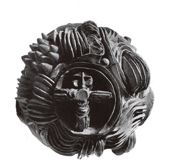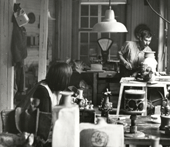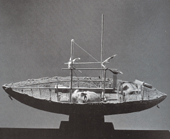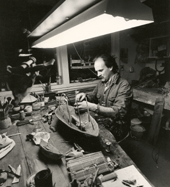|
When
Bertil Vallien left the College of Art, Crafts and Design, he had
no thought of working with glass. He went to USA, where almost overnight
he became an acclaimed celebrity. After 2 years there he left to
take up a new challenge- glass. He did not abandon pottery, however,and
during the 60s and 70s he was involved in the renewal of ceramic
art.
A precondition
for starting at the Åfors factory was that Bertil and Ulrica
would have a suitable place in which to work with their pottery.
They set up a work-shop, and installed a new kiln in the old painting
shed beside the Lyckeby river.
Throughout
the 1960s Bertil took part in numerous exhibitions of pottery -
often together with fellow potters, and nearly always with Ulrica.
The fact that he was one of the leading ceramic-artists in Sweden
is borne out by the many press cuttings from that period. His ceramic
work showed the same powerful exuberance that he had been developing
and refining ever since college days.
During
that same decade, the ongoing debate about the difference between
art and handicraft, was at its height. Bertil was one of the liveliest
champions of the view that glass and ceramics could indeed be seen
as art.
And proved
his point in the ‘New Pottery’ exhibition at the Handicraft
Society in Stockholm, in Spring, 1966.
This
exhibition provided the clearest indication of the new direction
for ceramics. Others who took part in the show, apart from Bertil
and Ulrica, were Lars Hellsten and Britt-Ingrid Persson. Bertil
showed his painted sculptures, one of which was bought by the National
Museum of Fine Art, Stockholm.
The New
Pottery exhibition drew positive interest from, i.a., ‘Design
Magazine’ and the national daily, Dagens Nyheter. Eugen Wretholm
(Design magazine) was impressed: “...He works with billowy,
rythmical folds, and likes to coat some of his *stoneware* pieces
with gaudy-coloured plastic lacquer. There is something relentless
in the blurring of boundaries, an uncompromising force in what he
does”
-The
lacquer coating was my youthful protest. Against the subdued style
of the sixties: the tedium of Scandinavian Design. Those of us who
took part in New Pottery had been Stig Lindberg’s students
at the college, and we were all influenced by the his style of expression,
Bertil says.
The tasks
to be performed at the factory were taking more and more of Bertil’s
time and energies. He did no ceramic work during the greater part
of the seventies. But in 1978 he made a comeback. The fruits of
an intensive period of work at home in Äfors were shown in
January, the following year at the Handicraft Society in Stockholm.
It was called “Vessels”.
The former
rich exuberance had been replaced by bare sculptures, in raw clay.
‘Vessels’ was a turning point in Vallien’s artistic
career. No longer was it BV the designer and problem solver, here
stood the artist, naked and exposed, without a safety net. It was
the first time that the public became acquainted with the form that
was to make him world famous – the boat.
-I had,
of course, been trained as a potter, but gradually my double role
of glass-designer/artist took up all my time. But I may very well
go back to ceramics again, once I have cut down on the glass.
|

Ararat
II, a painted sculpure, 1966. Photo:
Jan Tennek.

Sphere
(Klot), shown at "New Pottery" in 1966.
Photo: Stig T Karlsson.

Inside
Bertil´s and Ulrica´s workshop in Åfors, 1960´s.

Future
construction II (Framtidsbygge II), stoneware, 1979. Photo:
Ola Terje.

At
work in Bertil´s workshop 1979. Photo: Ola Terje.
|


